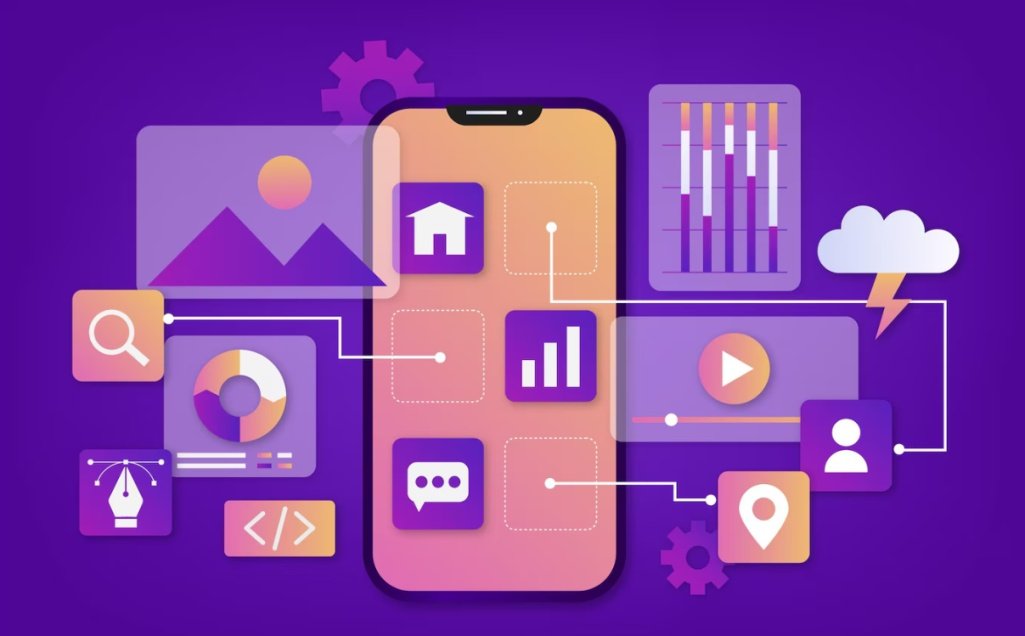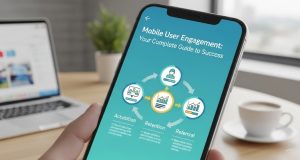The Ultimate Guide to Apps and Mobile Marketing in 2025

The Ever-Evolving Mobile Marketing Landscape
The above introduction shares about the nature of mobile marketing. Businesses wishing for success must cater to smartphones and tablets, however inconvenient it may be. Among smartphone users the world over, there are over 7.3 billion people who use such devices. If businesses do not consider these people in their marketing plans in future years to come ;if they ignore this opportunity of absolute magnitude–they risk falling into obscurity. Global app revenue will hit $613 billion by the end of 2025.Thus 2025 saw an even simpler version of thingstead into mobile marketing: using a sophisticated setup complete with data for user lifetime value, retention as well as meaningful engagement. Before talking about how it happened, let’s go see what has been said in the mobile marketing market in 2020.
Understanding the Mobile Marketing Ecosystem in 2025
The mobile marketing ecosystem encompasses various channels, platforms, and strategies designed to reach and engage users on mobile devices. These include:
App Store Optimization (ASO)
ASO remains the foundation of any successful mobile app marketing strategy. Just as SEO helps websites rank higher in search results, ASO improves an app’s visibility within app stores. Key ASO components include:
- Keyword optimization: Researching and implementing relevant keywords in your app title, subtitle, and description
- Visual elements: Creating compelling icons, screenshots, and preview videos
- Ratings and reviews: Actively managing and responding to user feedback
- Category placement: Selecting the most appropriate category for your app
According to App Annie’s State of Mobile 2025 report, apps with optimized listings see up to 70% more downloads than those with basic listings.
In-App Marketing Strategies
Once users install your app, effective in-app marketing tactics become crucial for engagement and retention:
- Personalized user experiences: Tailoring content based on user behavior and preferences
- Push notifications: Sending timely, relevant messages to re-engage users
- In-app messaging: Communicating important updates or offers within the app experience
- Loyalty programs: Rewarding frequent usage and engagement
- Deep linking: Creating seamless pathways between marketing channels and specific in-app content
Mobile Advertising Channels
The mobile advertising landscape has expanded beyond traditional display ads to include:
- Programmatic advertising: Automated buying and optimization of ad placements
- Native advertising: Ads that match the look and feel of the platform they appear on
- Video advertising: Short-form, engaging video content optimized for mobile viewing
- Rewarded advertising: Offering in-app rewards in exchange for viewing ads
- Playable ads: Interactive ad experiences that preview app functionality
Data-Driven Mobile Marketing: The Power of Analytics
Modern mobile marketing relies heavily on data analysis to inform strategy and measure success. Key metrics to track include:
User Acquisition Metrics
- Cost Per Install (CPI): The average cost to acquire one new user
- Cost Per Action (CPA): The cost to drive a specific in-app action
- Conversion Rate: The percentage of users who complete desired actions
- Attribution: Identifying which marketing channels drive the most valuable users
Engagement and Retention Metrics
- Daily Active Users (DAU) and Monthly Active Users (MAU): Measuring app usage frequency
- Session length: The average time users spend in your app per visit
- Retention rate: The percentage of users who return to your app after initial download
- Churn rate: The percentage of users who stop using your app within a specific timeframe
According to research from Mobile Marketing Association, businesses that implement sophisticated mobile analytics frameworks see a 23% higher return on their marketing investment compared to those using basic metrics.
Mobile Marketing Automation: Scaling Your Efforts
Marketing automation has revolutionized how businesses engage with mobile users at scale. Key automation strategies include:
User Segmentation
Creating distinct user groups based on behavior, demographics, and engagement patterns allows for targeted messaging that resonates with specific audience segments. Effective segmentation can increase engagement rates by up to 200% compared to broad-based campaigns.
Behavioral Triggers
Setting up automated responses to specific user actions creates timely, relevant communication:
- Onboarding sequences: Guiding new users through app features
- Re-engagement campaigns: Bringing back users who haven’t opened the app recently
- Milestone celebrations: Acknowledging user achievements within the app
- Cart abandonment reminders: Prompting users to complete interrupted purchases
A/B Testing and Optimization
Continuous experimentation is essential for improving mobile marketing performance:
- Testing different message formats: Determining which types of communication perform best
- Optimizing send times: Identifying when users are most receptive to messaging
- Refining creative elements: Testing various visual and copy approaches
- Experimenting with offers: Determining which incentives drive the most engagement
The Rise of Mobile-First Content Marketing
Content marketing has adapted to mobile consumption habits, with successful strategies focusing on:
Short-Form Video Content
Platforms like TikTok and Instagram Reels have transformed how brands communicate, with concise, visually engaging content capturing user attention in seconds. According to recent studies, mobile users are 1.5x more likely to engage with short-form video content compared to static images.
Mobile-Optimized Blogs and Articles
When creating content for mobile consumption:
- Use short paragraphs and sentences
- Incorporate bullet points and numbered lists
- Include compelling subheadings to improve scanability
- Optimize page loading speed for mobile devices
- Ensure responsive design across all screen sizes
Interactive Content Experiences
Interactive content forms like quizzes, polls, and augmented reality experiences drive significantly higher engagement rates on mobile devices. These formats encourage active participation rather than passive consumption, leading to stronger brand recall and deeper connections.
Privacy and Compliance in Mobile Marketing
As privacy regulations continue to evolve, mobile marketers must adapt their strategies to respect user privacy while still delivering personalized experiences:
First-Party Data Strategy
With the deprecation of third-party cookies and increasing restrictions on device identifiers like IDFA, building a robust first-party data strategy has become essential. This involves:
- Creating value exchanges that encourage users to share information willingly
- Implementing transparent data collection practices
- Building trust through clear privacy policies and consent mechanisms
- Leveraging owned channels like email and push notifications
Contextual Targeting
Instead of relying solely on user-level targeting, contextual approaches focus on serving relevant ads based on app content and user context:
- App category targeting: Showing ads in apps of similar or complementary categories
- Content relevance: Matching ad content to the surrounding app content
- Moment-based marketing: Targeting users based on situational factors like time of day, weather, or location
According to mobile marketing experts at MobileDominate.com, contextual targeting strategies have shown only a 5-10% decrease in performance compared to user-level targeting, while significantly improving privacy compliance.
Emerging Technologies Shaping Mobile Marketing
Several technologies are transforming the mobile marketing landscape in 2025:
Artificial Intelligence and Machine Learning
AI-powered tools now enable:
- Predictive analytics for user behavior forecasting
- Dynamic creative optimization that automatically adapts content to individual users
- Intelligent chatbots that provide personalized customer service
- Advanced audience segmentation based on complex behavioral patterns
Augmented Reality Marketing
AR experiences create immersive brand interactions:
- Virtual try-on features for retail apps
- Interactive product demonstrations
- Location-based AR experiences that blend digital and physical worlds
- Gamified marketing campaigns with AR elements
Voice Search Optimization
As voice assistants continue to gain popularity, optimizing for voice search has become crucial:
- Focusing on conversational keywords and natural language
- Creating FAQ content that answers common voice queries
- Ensuring business information is accurate across all platforms
- Optimizing for local search terms and “near me” queries
Creating an Integrated Mobile Marketing Strategy
Successful mobile marketing rarely relies on a single channel or tactic. Instead, it integrates multiple approaches into a cohesive strategy:
Omnichannel Experience
Users expect seamless experiences across all touchpoints:
- Consistent messaging and branding across channels
- Synchronized data between mobile apps and other platforms
- Persistent shopping carts and user preferences
- Unified customer service across all channels
Growth Loop Creation
Building sustainable growth loops involves:
- Identifying key moments that encourage sharing and virality
- Implementing referral programs that incentivize user acquisition
- Creating features that naturally drive user-generated content
- Designing retention hooks that keep users coming back
Measurement and Attribution
Comprehensive measurement frameworks track the customer journey across channels:
- Multi-touch attribution: Understanding the contribution of each marketing touchpoint
- Incrementality testing: Measuring the true impact of marketing activities
- Lifetime value prediction: Forecasting long-term user value from early signals
- ROAS optimization: Maximizing return on advertising spend across channels
Conclusion: The Future of Mobile Marketing
As we progress through 2025, mobile marketing continues to evolve at a rapid pace. Successful marketers must balance technological innovation with human-centered approaches that respect user privacy and deliver genuine value.
The most effective mobile marketing strategies will be those that combine data-driven decision-making with creative storytelling, creating experiences that users genuinely want to engage with. By staying informed about emerging trends and continuously optimizing your approach, you can position your brand for mobile success in this dynamic landscape.
Whether you ‘re developing a brand new app of your own or improving your present mobile advertising campaign, the rules in this guide will enable you understand complicated nature mobile ecosystem and make contact meaningfully with your core readers.
This guide helps you grasp not only the complex possibilities of the mobile ecosystem but also how it continues to evolve. Whether your focus is on acquiring new customers (through ringtones, apps, or games for example) or retaining existing ones who have ever checked out anything on your site-the Tactics for Mobile Phone Marketing will provide practical guidance that can be applied immediately You as a manager of businesses should always have in mind producing worth both partners.`
`The most successful strategies in mobile marketing, as in all digital marketing disciplines, are those that continually evolve. Always test, learn from your tests, optimize your results, and then pass after which begin the process all over again – never letting up in its pursuit of creating value not only for yourself but also those whom you serve.








